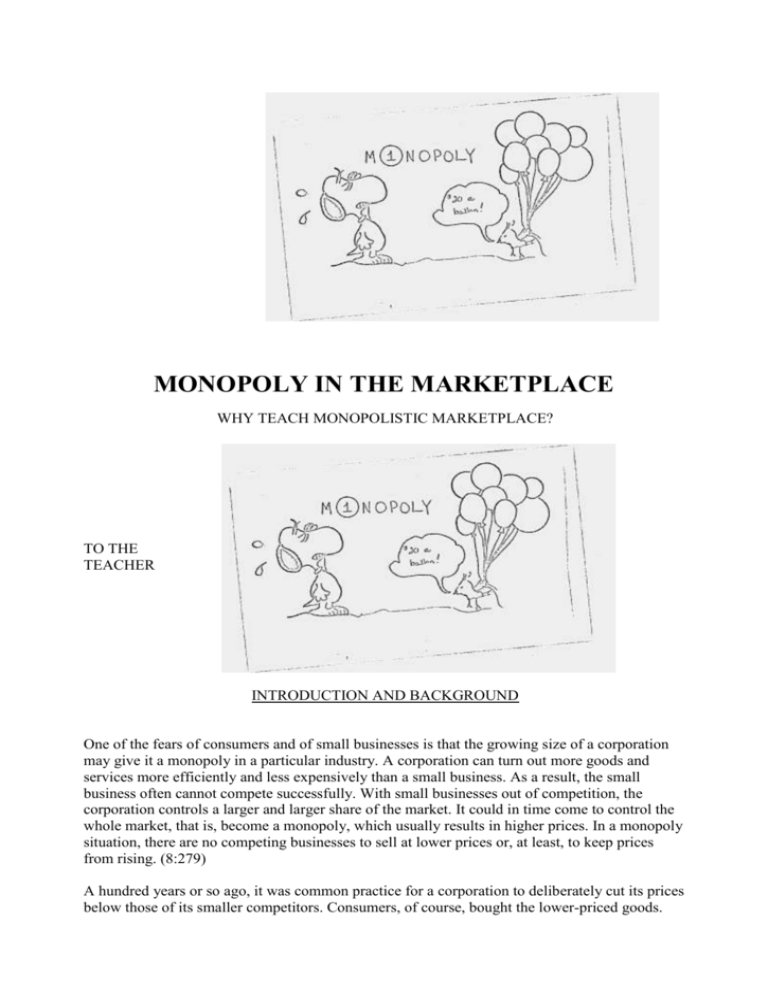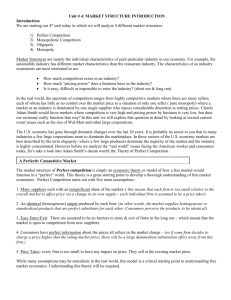monopoly in the marketplace
advertisement

MONOPOLY IN THE MARKETPLACE WHY TEACH MONOPOLISTIC MARKETPLACE? TO THE TEACHER INTRODUCTION AND BACKGROUND One of the fears of consumers and of small businesses is that the growing size of a corporation may give it a monopoly in a particular industry. A corporation can turn out more goods and services more efficiently and less expensively than a small business. As a result, the small business often cannot compete successfully. With small businesses out of competition, the corporation controls a larger and larger share of the market. It could in time come to control the whole market, that is, become a monopoly, which usually results in higher prices. In a monopoly situation, there are no competing businesses to sell at lower prices or, at least, to keep prices from rising. (8:279) A hundred years or so ago, it was common practice for a corporation to deliberately cut its prices below those of its smaller competitors. Consumers, of course, bought the lower-priced goods. When reduced sales forced the competitors out of business, the small businesses were bought up by the corporation. Then the corporation would raise the prices to high levels. This unfair strategy once used by corporations is called cutthroat competition. (8:279) Critics of the abuse of power by corporations also point to the practice of price-fixing. When there are only a small number of corporations in a given field for example, steel, copper, or drugs-one way of stifling competition and keeping prices high is for the corporations to agree illegally to charge the same price. Thus, if steel is price-fixed, a ton of steel costs the same no matter from which corporation it is bought. Of course, the fixed price would be higher than one set by free competition. (8:280) Government Regulation of Competition. Because consumers obtain benefits from competition, our government has traditionally sought to maintain a competitive environment for business. This has often taken the form of laws or regulations intended to prevent abuses in specific areas. Of course, many government regulations also deal with product standards, environmental impacts, and other matters not directly related to competition. It's obvious that without competition, prices of goods and services tend to be higher than they would be with competition- and output is lower. When there is little competition, producers can be relatively inefficient without being penalized, and manpower and other resources can be wasted. (2:10) It was in response to such abuses of power by large corporations that the federal government passed antitrust (anti-monopoly) laws. These laws are aimed at encouraging honest competition. They seek to prevent practices which interfere with the freedom of the consumer to get the highest quality at the lowest price, or of the worker to bargain for fair wages and decent working conditions. (8:280) As long ago as 1890, Congress passed a major piece of legislation regulating business-the Sherman Anti-Trust Act. The objective was to prevent two or more persons from getting together to "restrain trade." This could involved forming a monopoly, where a single producer dominates an industry so that it can set prices or control supply without regard to competition. It could also involve price fixing, the agreement among several firms to set prices to avoid competition. (2:10) There are some cases where competition may not be in the public interest. An example is a public utility that supplies electricity or natural gas or water. Duplication of local power, gas or water lines could result in higher rates. But if there is no competition, how should prices be determined? In such cases, the state or local governments regulate the prices of the services, keeping in mind the interest of the public and the costs involved. The issue of government regulation of many areas of business, such as food, transportation, and energy, is constantly before us. Are certain businesses over-regulated? Are they under-regulated? How can regulation be used to improve competition? These and other questions must be examined as we look at the role of government regulation in our economic lives. (2:10) MONOPOLISTICS MARKETPLACE Teacher Information: This page is teaching information. Information may be adapted to use as learning activities for students. STUDENT OBJECTIVES INCORPORATED After completion of this packet, students will recognize: What a monopoly situation is Bow government regulates monopolies MONOPOLISTICS MARKETPLACE Teacher Information: This page is teaching information. Information may be adapted to use as learning activities for students. HOW TO USE: TEACHER INFORMATION SHEETS WILL PROVIDE THE TEACHER WITH A BASIS FOR A STARTING A UNIT AND LESSON PLANS. LEARNING ACTIVITY SHEET WILL PROVIDE CLASSROOM PRESENTATION IDEAS AND LEARNING STRATEGIES FOR STUDETNS. OPTIONAL LEARNING ACTIVITY SHEETS CAN BE AN OPTIONAL LEARNING ACTIVITY TO EMPHASIZE CONCEPTS FOR STUDENTS. MONOPOLISTICS MARKETPLACE Teacher Information: This page is teaching information. Information may be adapted to use as learning activities for students THE WHY BEHIND THE IMPORTANCE OF TEACHING.. ABOUT MONOPOLISTIC MARKETPLACE An understanding of monopolies, price fixing and how government regulates them in our daily lives is helpful for students to become informed citizens. Only if student consumer decision making is based upon adequate understanding of our economic system, can decision making be considered wisely. BASIC PRINCIPLES INCORPORATED A single producer dominating an industry so that it can set prices or control supply without regard to competition is known as a monopoly. In a monopoly situation, there are no competing businesses to sell at lower prices or, at least, to keep prices from rising. Government regulations respond to such abuses of power by monopolies by anti-trust laws. These laws are aimed at encouraging honest competition. Learning Activity MONOPOETRY EVIL KNIVEL Evil Knivel is quite a man, He can jump quite a lengthy span. On motorcycling stunts he has a monopoly, You'll never catch him driving sloppily. BILLY KING Billie Jean King is a tennis pro. She makes lots of dough. She has a monopoly on winning tournaments, All her opponents have much to lament. TELEPHONE COMPANY Some companies own all the rights. When we listen with our ears and enjoy without sight. We can only use the phone of one company. Because it is the only one; there is not that many: SUPER CORN One night in July A farmer's corn grew very high He took to market And people bought it and bought it Because his corn was so golden sweet and good No one could compete like they should Other farmers' corn rotted and was not sold The other farmers went out of business we were told. HENRY'S POND (Fish.-o-monopoly) Henry's pond in the South Had special fish with special mouths Why people from all around Would travel just to find the fish to be found The special mouths of fish Caused them to easily end up as a family dinner dish But all other fishing ponds like Sue Ellen’s Pond and Ripple Ridge Lake Went out of business…what a pity sake. Monopoly Learning Activity: this page is suitable for an overhead transparency or individual work sheet, etc The GEE Tennis Ball, Inc. has 250 employees. The company controls of tennis ball industry in the area. All the tennis players must buy their tennis balls from GEE Tennis Ball, Inc. Recently, the GEE Tennis Ball, Inc. management decided to raise the price of tennis balls from 3 for $1.00 to 3 for $10.00. What do you think were the tennis players reactions? What could the tennis players do about this high price? What options do the tennis players have? Learning Activity: this page is suitable for an overhead transparency or individual work sheet, etc SUCKER---POLY Directions--Step 1 Give 3 members of the class paper change and 60 suckers to sell with instructions to increase and lower prices each round of buying. (ex. $1.00 = 1st round; $.50 = 2nd round; $3.00 = 3rd round and $4.00 = 4th round) Round 1: (3 mm.) Give each student $5.00 to spend on suckers with instructions that they do not necessarily have to buy each round. Round 2: (2 mm.) Have sellers post price sign. Proceed with buying by consumer. Round 3: (5 mm.) Have sellers post price sign. Proceed with buying by consumer. Round 4: (5 mm.) Have sellers post price sign. Proceed with buying by consumer. Have sellers post price sign. Proceed with buying by consumer. How did you feel about the prices? Did you get your money's worth? How does a monopolistic market compare with competition in the marketplace? What could be done to prevent this monopoly price fixing? Learning Activity: this page is suitable for an overhead transparency or individual work sheet, etc MONOPOLY CLASSROOM STRATEGIES Have student groups play monopoly, but with a slight variation--have a lottery winner per group. Then give the winner extra money, ownership, etc to promote a monopoly. Follow the activity with the following questions: What happened when one person controlled so much? Does this happen to consumers today? What is a monopoly? Have a guest speaker talk about a local "monopoly" in your town. Example: telephone company, utility, post office, etc. Have your state representative talk (or write to your representative) about how government controls monopolies. Use the WIDGET GAME (See Competition in the Market pak) to show how big business could become a monopoly by producing in a short time a small company by having 2/3 of the class in one company and 1/3 the other company.







